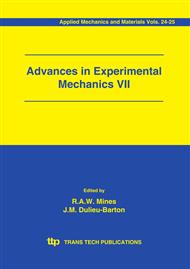p.51
p.57
p.65
p.71
p.77
p.83
p.91
p.97
p.103
Investigation into the Damping and Stiffness Characteristics of an Elevator Car System
Abstract:
Modelling the dynamic performance of an elevator car system represents a complex task and forms an important step in the elevator system design procedure. The need to consider the behaviour of passengers travelling in the car complicates the procedure further. This paper presents an original approach to identify the stiffness and damping characteristics of an elevator car system. A simplified model is developed and the experimental rig with a rectangular elevator platform fixed on the top of four silent blocks attached to a shaker is setup. The transmissibility measurements are carried out with a harmonic excitation applied first to a platform with no passenger load and then to the platform with one passenger within the frequency range of 1 – 20 Hz. A single person standing on the platform is employed in order to assess the passenger’s contribution to the dynamic behaviour of the elevator car system. The curve fitting technique implemented in MATLAB is used to determine the damping and stiffness coefficients both for the empty car system and the car-passenger system. Investigation on the tolerances for both parameters is carried out. An approach to simplify the experimental procedure and to reduce the number of individual tests is proposed.
Info:
Periodical:
Pages:
77-82
Citation:
Online since:
June 2010
Authors:
Permissions:
Share:
Citation:


